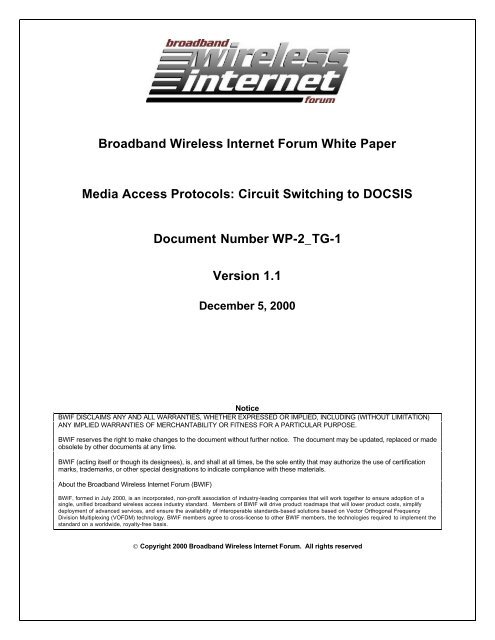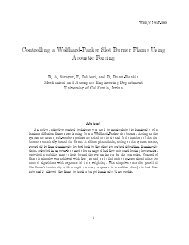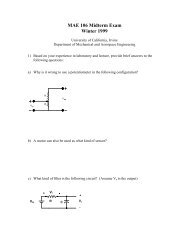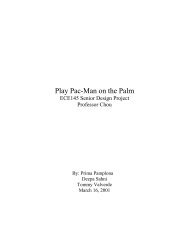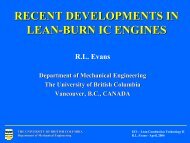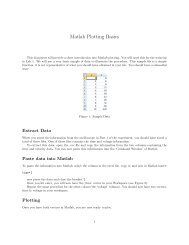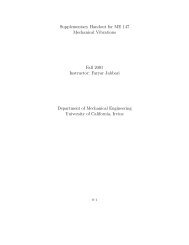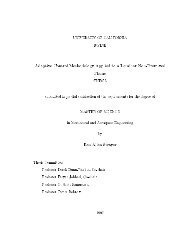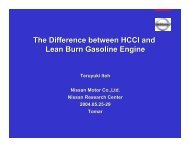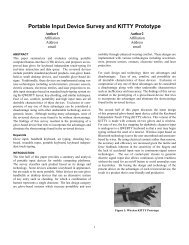Broadband Wireless Internet Forum White Paper Media Access ...
Broadband Wireless Internet Forum White Paper Media Access ...
Broadband Wireless Internet Forum White Paper Media Access ...
You also want an ePaper? Increase the reach of your titles
YUMPU automatically turns print PDFs into web optimized ePapers that Google loves.
<strong>Broadband</strong> <strong>Wireless</strong> <strong>Internet</strong> <strong>Forum</strong> <strong>White</strong> <strong>Paper</strong><strong>Media</strong> <strong>Access</strong> Protocols: Circuit Switching to DOCSISDocument Number WP-2_TG-1Version 1.1December 5, 2000NoticeBWIF DISCLAIMS ANY AND ALL WARRANTIES, WHETHER EXPRESSED OR IMPLIED, INCLUDING (WITHOUT LIMITATION)ANY IMPLIED WARRANTIES OF MERCHANTABILITY OR FITNESS FOR A PARTICULAR PURPOSE.BWIF reserves the right to make changes to the document without further notice. The document may be updated, replaced or madeobsolete by other documents at any time.BWIF (acting itself or though its designees), is, and shall at all times, be the sole entity that may authorize the use of certificationmarks, trademarks, or other special designations to indicate compliance with these materials.About the <strong>Broadband</strong> <strong>Wireless</strong> <strong>Internet</strong> <strong>Forum</strong> (BWIF)BWIF, formed in July 2000, is an incorporated, non-profit association of industry-leading companies that will work together to ensure adoption of asingle, unified broadband wireless access industry standard. Members of BWIF will drive product roadmaps that will lower product costs, simplifydeployment of advanced services, and ensure the availability of interoperable standards-based solutions based on Vector Orthogonal FrequencyDivision Multiplexing (VOFDM) technology. BWIF members agree to cross-license to other BWIF members, the technologies required to implement thestandard on a worldwide, royalty-free basis.Copyright 2000 <strong>Broadband</strong> <strong>Wireless</strong> <strong>Internet</strong> <strong>Forum</strong>. All rights reserved
December 5, 2000<strong>Broadband</strong> <strong>Wireless</strong> <strong>Internet</strong> <strong>Forum</strong>Table of Contents1 INTRODUCTION........................................................................................................................................................................ 51.1 CIRCUIT SWITCHING VS. PACKET SWITCHING ................................................................................................................62 CLASSIFICATION OF MAC PROTOCOLS .................................................................................................................... 73 DEMAND ASSIGNMENT PROTOCOL EXAMPLES FROM THE LITERATURE............................................104 PROTOCOL EXAMPLES FROM THE INDUSTRY.....................................................................................................115 ADVANTAGES OF DOCSIS...............................................................................................................................................146 DOCSIS OPERATION ...........................................................................................................................................................177 CONCLUSIONS .......................................................................................................................................................................20© Copyright 2000, <strong>Broadband</strong> <strong>Wireless</strong> <strong>Internet</strong> <strong>Forum</strong>, a program of the IEEE Industry Standards and Technology Organization (IEEE-ISTO). All rights reserved.Page 2
December 5, 2000<strong>Broadband</strong> <strong>Wireless</strong> <strong>Internet</strong> <strong>Forum</strong>List of FiguresFigure 1: Link utilization.....................................................................................................................................................................6Figure 2: IEEE 802.14 channel access......................................................................................................................................12Figure 3: DOCSIS channel access..............................................................................................................................................13Figure 4: IP transfer delay comparison of DOCSIS and IEEE 802.14. ...........................................................................16Figure 5: DOCSIS Allocation Map. ..............................................................................................................................................18Figure 6: MAC frame header and data PDU format. .............................................................................................................19© Copyright 2000, <strong>Broadband</strong> <strong>Wireless</strong> <strong>Internet</strong> <strong>Forum</strong>, a program of the IEEE Industry Standards and Technology Organization (IEEE-ISTO). All rights reserved.Page 3
December 5, 2000<strong>Broadband</strong> <strong>Wireless</strong> <strong>Internet</strong> <strong>Forum</strong>ABSTRACTIn this white paper, we discuss why DOCSIS has been chosen as the <strong>Media</strong> <strong>Access</strong>Control (MAC) protocol of the <strong>Broadband</strong> <strong>Wireless</strong> <strong>Internet</strong> <strong>Forum</strong> specifications. Wedescribe the evolution of MAC protocols from local area networks to broadband accessnetworking and show why, among existing alternatives, DOCSIS is the best one.© Copyright 2000, <strong>Broadband</strong> <strong>Wireless</strong> <strong>Internet</strong> <strong>Forum</strong>, a program of the IEEE Industry Standards and Technology Organization (IEEE-ISTO). All rights reserved.Page 4
December 5, 2000<strong>Broadband</strong> <strong>Wireless</strong> <strong>Internet</strong> <strong>Forum</strong>1 IntroductionA MAC protocol allocates the use of a communications channel to independent competingusers. Standards organizations have developed or adopted several MAC protocols forvarious purposes, e.g., IEEE 802.3, 802.11, 802.14, Cable Labs DOCSIS, etc. Thesedifferent protocols address various types of network environments such as Local AreaNetworks (LANs), wireless LANs, Hybrid Fiber/Coax (HFC) networks, etc. Other MACprotocols have been designed for cellular mobile networks, satellite networks, etc. Theperformance of a MAC protocol depends on the network environment and the trafficcharacteristics. It is extremely important to understand that a MAC protocol that can worksufficiently well with one type of traffic source may perform poorly with another type oftraffic source. The performance degradation can be severe. A particular case of verysignificant performance degradation occurs when circuit switching is used to multiplexbursty data sources. In the early days of networking, circuit switching versus packetswitching was studied from a performance and a cost viewpoint (see, for example, [1, 2,3]). A classical text on the subject states that the exact choice between circuit and packetswitching is a difficult one and a satisfactory comprehensive treatment of the varioustradeoffs does not exist [4, p. 296]. Nevertheless, a general rule of thumb was accepted:Circuit switching is suitable for networking with constant bit rate voice or video, but packetswitching is preferred for bursty data sources such as computer or terminal data [4, p.296]. The statement that the tradeoff between circuit and packet switching is notunderstood well may indeed have been true at the time [4] was written (1976) when circuitswitching technology was much less expensive and more scalable than packet switching.However, today packet switching is much better developed and its performance and costtradeoffs are very well understood. In fact, in the new networking paradigm, packetswitching is the only multiplexing technique for all sources including voice, video, and dataunder both <strong>Internet</strong> Protocol (IP) and Asynchronous Transfer Mode (ATM) scenarios. Wewill address this issue in detail next.© Copyright 2000, <strong>Broadband</strong> <strong>Wireless</strong> <strong>Internet</strong> <strong>Forum</strong>, a program of the IEEE Industry Standards and Technology Organization (IEEE-ISTO). All rights reserved.Page 5
December 5, 2000<strong>Broadband</strong> <strong>Wireless</strong> <strong>Internet</strong> <strong>Forum</strong>1.1 Circuit Switching vs. Packet SwitchingIt is easy to quantify the throughput gain via packet switching for bursty data sources. Wewill do that by employing an example [5]. Refer to Figure 1. Let λ be the message arrivalrate, or equivalently let 1/λ be the average interarrival time between messages in asession. Let X be the average transmission time of a message over a given link in thepath. The ratio of X to 1/λ or λX is the fraction of time the link is busy. Note that 0≤ λX ≤1and λX can be used as a figure of merit, representing the occupancy of the link.Now let T be the allowable delay in transmitting the message from source to destination.Due to the presence of propagation delays, switching delays, queueing delays, etc, wehave X ≤ T therefore λX
December 5, 2000<strong>Broadband</strong> <strong>Wireless</strong> <strong>Internet</strong> <strong>Forum</strong>including Web use studies, indicate the following results regarding computer responsetimes [6, 7]:• 0.1 s is about the limit for having the user feel that the system is reactinginstantaneously,• 1 s is about the limit for the user’s flow of thought to stay uninterrupted, but the user willnotice the delay,• 10 s is about the limit for keeping the user’s attention focused on the dialogue.Thus, the target response time for easy Web use is less than 1 s. Consequently, T < 1 sand we have λT < 0.067, or about a 15X advantage in using packet switching ascompared to circuit switching with Web use.There exist various techniques, known in general as fast circuit switching (see e.g., [8])that are based on the set up and tear down of a circuit at the beginning and end of eachmessage. Such techniques have milder throughput degradations as compared to circuitswitching. However, they suffer from large delays due to the setting up and tearing downof circuits. Also, the large number of signaling messages on the network backbonebecomes a significant consideration.A further advantage of packet switching relates to a subjective advantage, in addition tothe throughput, delay, and signaling complexity advantages described above. For a userpopulation of N users, circuit switching can deliver at best 1/N of the total channel capacityto each user; whereas with packet switching a user can access the full bandwidth of thechannel in an instantaneous manner.2 Classification of MAC ProtocolsMAC protocols are usually classified into the following basic categories1. Fixed assignment techniques2. Contention algorithms© Copyright 2000, <strong>Broadband</strong> <strong>Wireless</strong> <strong>Internet</strong> <strong>Forum</strong>, a program of the IEEE Industry Standards and Technology Organization (IEEE-ISTO). All rights reserved.Page 7
December 5, 2000<strong>Broadband</strong> <strong>Wireless</strong> <strong>Internet</strong> <strong>Forum</strong>3. Demand assignment techniques.It is possible to combine these techniques, and sometimes a fourth such category, mixedmodes, is defined to address the combination.Fixed Assignment Techniques are essentially circuit switching techniques. Theyincorporate permanent subchannel assignments. Examples of fixed assignmenttechniques as MAC protocols are Time Division Multiple <strong>Access</strong> (TDMA), FrequencyDivision Multiple <strong>Access</strong> (FDMA), and Code Division Multiple <strong>Access</strong> (CDMA). As statedabove, these classical schemes perform well with stream type traffic where each usertransmits a steady flow of messages such as constant bit rate voice or video. The systemenables a large percentage of the subchannels to carry user traffic. The result is the highutilization of the communications channel. As shown above, however, fixed assignmenttechniques are inefficient in bursty traffic applications. A subchannel is wasted wheneverits owner does not have anything to transmit.Contention Algorithms have two general categories. One category is known as Random<strong>Access</strong> Algorithms and the other as Collision Resolution Algorithms. Random accessalgorithms aim to make the full channel capacity available to users, for short periods oftime, on a random basis. They are packet oriented, whereas the fixed assignmenttechniques are channel oriented. They dynamically allocate transmission capacity on a perpacket basis. The simplest random access protocol, pure ALOHA, permits users totransmit at will [9]. Whenever one user’s transmission overlaps any part of another user’stransmission, a collision occurs and both messages must be retransmitted. When thechannel is lightly loaded, few collisions occur in ALOHA-based schemes. Thus theexpected delay, from the arrival of a packet until its successful transmission, is very small.When collisions occur, users retransmit with random delays. This increases delay andreduces throughput at high loads. In addition, ALOHA schemes are inherently unstable. Asan extension of the pure ALOHA algorithm, sensing the channel prior to transmissionresults in the Collision Sense Multiple <strong>Access</strong> (CSMA) algorithm. This reduces the numberof collisions and consequently, increases throughput and reduces delay. If the users candetect collisions shortly after transmission, then they can use the Carrier Sense Multiple© Copyright 2000, <strong>Broadband</strong> <strong>Wireless</strong> <strong>Internet</strong> <strong>Forum</strong>, a program of the IEEE Industry Standards and Technology Organization (IEEE-ISTO). All rights reserved.Page 8
December 5, 2000<strong>Broadband</strong> <strong>Wireless</strong> <strong>Internet</strong> <strong>Forum</strong><strong>Access</strong>/Collision Detection (CSMA/CD) algorithm. This is the algorithm used in Ethernet(IEEE 802.3). Despite the improvements achieved with carrier sensing techniques, thestability problems of pure ALOHA still persist in CSMA/CD. Furthermore, performancedegrades as the maximum propagation delay between users increases. In wirelesschannels, it is very difficult to sense collisions. For this environment, Collision Avoidance(CA) algorithms have been developed. In these algorithms, a user waits for a randomperiod before transmission after the channel becomes idle; if it does not receive anacknowledgement from the central controller after transmission, it increases the randomperiod before transmission. CSMA/CA is the basis of the IEEE 802.11 standard forwireless LANs.The second category of contention algorithms is known as Collision Resolution algorithms.These were invented to improve the maximum achievable stable throughput of randomaccess protocols. The basic idea is to assign retransmission times after collisionsdeterministically to a subgroup of all users so that idle channel periods due to randomretransmission times are avoided. There is a family of such algorithms, known as splittingor tree algorithms [5]. Of primary importance, these techniques guarantee system stability,provided the input rate to the network is not too large.Demand Assignment Techniques achieve high channel throughput by requiring users toreserve communication bandwidth. A portion of the channel capacity is required in thisreservation stage. The reservation subchannel is accessed by users according to amultiple access protocol, such as TDMA or Slotted ALOHA. Short reservation packets aresent to request channel time; the shorter they are, the less capacity is necessary for thereservation subchannel. Once channel time is reserved, information packets aretransmitted conflict-free. Conflicts occur only on the small capacity reservation subchannel.Users wait for their reservations to be accepted, and are assigned transmission times.Thus, at low throughputs, the message delay is increased over that of random accesstechniques. This can be remedied by using this reservation channel for the transmission ofshort data messages, in addition to reservation packets. A special case of demandassignment techniques is polling where each user is addressed sequentially by a centralstation for transmission privileges.© Copyright 2000, <strong>Broadband</strong> <strong>Wireless</strong> <strong>Internet</strong> <strong>Forum</strong>, a program of the IEEE Industry Standards and Technology Organization (IEEE-ISTO). All rights reserved.Page 9
December 5, 2000<strong>Broadband</strong> <strong>Wireless</strong> <strong>Internet</strong> <strong>Forum</strong>We want to emphasize that for data and voice sources, demand assignment MACprotocols have the best performance. Fixed assignment, or circuit switching, is notacceptable due to its poor delay and throughput performance with data sources. Even fastcircuit switching has poor delay performance. In addition, it generates too many signalingmessages on the backbone network. Contention algorithms are also not applicable due totheir low throughput. Also, they are not suitable for combining voice and video.3 Demand Assignment Protocol Examples from the LiteratureTwo demand assignment algorithms are well-known and have been studied in detail in theliterature. In Packet Reservation Multiple <strong>Access</strong> (PRMA), each time slot is recognized as“reserved” or “available” according to an acknowledgement message from the centralcontroller [10]. When a user with a periodic source successfully transmits a packet in anavailable slot to the central station using the Slotted ALOHA protocol, that slot becomesreserved in future frames and there are no subsequent collisions from other terminals untilthe end of its burst. At the end of the burst, the reservation is released, leaving the slotempty. Random information packets contend for available time slots using Slotted ALOHA.However, when a random packet is successfully transmitted, the mobile does not obtaintime slot reservation. PRMA was the first MAC protocol that described a way to transmitperiodic data using a conventional MAC protocol. In other words, it was the first protocol inthe literature to combine data and voice. Its performance has been studied extensively inthe literature.Distributed Queueing Request Update Multiple <strong>Access</strong> (DQRUMA) [11] is a demandassignment protocol where1. When requests are made the size of the message is declared at the onset (so that,unlike PRMA, a time slot is not wasted at the end to release reservation),2. If, after the initial request, the user receives further packets to transmit, furtherreservation requests are piggybacked onto data packets in transmission (rather thangoing through the reservation channel).© Copyright 2000, <strong>Broadband</strong> <strong>Wireless</strong> <strong>Internet</strong> <strong>Forum</strong>, a program of the IEEE Industry Standards and Technology Organization (IEEE-ISTO). All rights reserved.Page 10
December 5, 2000<strong>Broadband</strong> <strong>Wireless</strong> <strong>Internet</strong> <strong>Forum</strong>DQRUMA has been introduced recently [11]. Nevertheless, there exist enhancements andperformance studies on DQRUMA in the literature. We have introduced PRMA andDQRUMA here since their basic concepts have been employed in the development ofMAC protocols for new access networks, for example, in DOCSIS. Also, in the engineeringliterature, state-of-the-art MAC protocol discussions evolve around PRMA and DQRUMA.MAC protocols developed by the industry can handle more detailed service andtransmission types than PRMA and DQRUMA. We will describe these protocols in the nextsection.4 Protocol Examples from the IndustryTogether with the introduction of HFC networks, three efforts to design MAC protocolsbegun: IEEE 802.14 and DOCSIS in the U.S. and DAVIC in Europe.IEEE 802.14 Working Group is a committee of engineers representing the HFC vendorcommunity. This committee has developed a specification for data over cable networking.The group was formed in May 1994 and had intended to develop a specification that wouldbe recognized as an international physical layer and MAC protocol standard for HFCnetworks. Because of the development of DOCSIS, IEEE 802.14 remains as a draft, it hasnot been accepted by the IEEE LAN/MAN Standard Committee. IEEE 802.14 chose ATMtransfer as its default solution. A byte is added to each ATM cell to form a MAC dataProtocol Data Unit (PDU). We will describe channel access in IEEE 802.14 next.In this protocol, the headend tightly controls the initial access to the Contention Slots (CS)as well as managing the Collision Resolution Protocol (CRP) by assigning a RequestQueue (RQ) number to each contention slot. Upon receipt of a data packet, the stationgenerates a Request Minislot Data Unit (RMDU). An admission control scheme fornewcomer stations is used to provide differentiated initial contention access. This schemeis based on preassigned priorities and a FIFO service of timestamped requests. Theheadend controls the station’s entry by sending an Admission Time Boundary (ATB)periodically (refer to Figure 2). Thus only stations with a generated RMDU time less thanATB are eligible to enter the contention process. Once the RMDU is generated, the station© Copyright 2000, <strong>Broadband</strong> <strong>Wireless</strong> <strong>Internet</strong> <strong>Forum</strong>, a program of the IEEE Industry Standards and Technology Organization (IEEE-ISTO). All rights reserved.Page 11
December 5, 2000<strong>Broadband</strong> <strong>Wireless</strong> <strong>Internet</strong> <strong>Forum</strong>Figure 2: IEEE 802.14 channel access.waits for a CS Allocation message from the headend that reserves a group of CS withRQ=0 for newcomer transmission. The station randomly selects a CS in that group andtransmits its RMDU. Since multiple stations may attempt to send their RMDUs in the sameupstream CS, a collision may occur. A feedback message is sent to the station after aroundtrip time (which is also equal to a frame length) informing it of the status of the CSslot used. In the case of a successful request transmission, the station activates its datatransmission state machine and exits the contention process. Subsequently a Data Grantmessage will be sent by the headend. In the case of a collided CS, the feedback messagecontains a particular RQ number to be used for collision resolution. That is, the stationneeds to retransmit its request in a CS group with that RQ number. The CS groups areusually located in the order of decreasing RQ values. For each RQ value the headendassigns a group of CS and an associated splitting value (SPL) that is by default equal to 3.A CS within the group is selected randomly in the range [0,…,SPL-1].DOCSIS stands for Data Over Cable Service Interface Specifications. It is developed by alimited partnership consisting of cable operators, called Multimedia Cable Network System© Copyright 2000, <strong>Broadband</strong> <strong>Wireless</strong> <strong>Internet</strong> <strong>Forum</strong>, a program of the IEEE Industry Standards and Technology Organization (IEEE-ISTO). All rights reserved.Page 12
December 5, 2000<strong>Broadband</strong> <strong>Wireless</strong> <strong>Internet</strong> <strong>Forum</strong>Partners Ltd. (MCNS). DOCSIS assumes that the packets it transmits are IP packets,although provisions exist for the transmission of ATM cells as well. Next we will describechannel access in DOCSIS.In DOCSIS, access to the upstream channel is controlled via a backoff window set by theheadend. This includes both the initial transmission of a request and any subsequenttransmissions of collided requests. The headend controls the initial access to thecontention slot by setting an initial backoff window, or Data Backoff Start defined in theAllocation Map (refer to Figure 3). The station then randomly selects a number within itsbackoff window. The random value indicates the number of contention transmitopportunities, which the station must defer before transmitting. After a contentiontransmission, the station waits for either a Data Grant or an Acknowledgement in asubsequent Allocation Map. Upon receipt of a station’s request (in the case of a successfultransmission), the headend processes it and assigns a data slot to the station by sending aData Grant in the Allocation Map. The headend may send an Acknowledgement messageto the station if it needs more time to process the request before it sends the Data Grant.Since multiple stations may attempt to send their request in the same upstream CS acollision may occur. But, unlike 802.14, the headend does not need to send an explicitFigure 3: DOCSIS channel access.© Copyright 2000, <strong>Broadband</strong> <strong>Wireless</strong> <strong>Internet</strong> <strong>Forum</strong>, a program of the IEEE Industry Standards and Technology Organization (IEEE-ISTO). All rights reserved.Page 13
December 5, 2000<strong>Broadband</strong> <strong>Wireless</strong> <strong>Internet</strong> <strong>Forum</strong>feedback message on the status of each CS. The station detects the collided slot when itdoes not find an Acknowledgement or Data Grant for it in the Allocation Map. The stationmust then increase its backoff window by a factor of two as long as it is less than themaximum backoff window set in the Allocation Map. The station randomly selects anumber within its new window and repeats the contention process described above. After16 unsuccessful retries the station discards the MAC PDU.DAVIC stands for Digital Audio Visual Council. This consortium developed a standard forvideo distribution over cable systems, specifically for Europe. There is a competing form ofDOCSIS (DOCSIS Euro), and therefore the future deployment of DAVIC is uncertain.Currently, Version 1.5 of the standard has been defined. Similar to IEEE 802.14, DAVIChas an ATM cell-based transmission format. It specifies ATM framing using LLC/SNAP(RFC 1483) and AAL5 (ITU-T I.363.5) to encapsulate IP (RFC 791) packets.5 Advantages of DOCSISIn comparing MAC protocols, the following criteria are used as a minimum:• Acceptance of a MAC for existing standards,• Maturity of protocol,• Wide acceptance and deployment,• Ability to handle various types of traffic and variable length packets,• <strong>Access</strong> delay and throughput, particularly for IP packets,• Support of QoS guarantees, end-to-end QoS guarantees, and the ability to satisfycustomer Service Level Agreements,• Simplicity of implementation,• Scalability,• Robustness,• Security,• Authentication,• Management functions, and• Ability to work with different physical layers.© Copyright 2000, <strong>Broadband</strong> <strong>Wireless</strong> <strong>Internet</strong> <strong>Forum</strong>, a program of the IEEE Industry Standards and Technology Organization (IEEE-ISTO). All rights reserved.Page 14
December 5, 2000<strong>Broadband</strong> <strong>Wireless</strong> <strong>Internet</strong> <strong>Forum</strong>As of this writing, DOCSIS is the accepted HFC standard by equipment vendors both inthe U.S. and in Europe. It has become an ITU-T standard (J.112). DOCSIS is a matureprotocol. It has been widely simulated and tested. It has also been widely deployed in thecable environment. There are some limited wireless MMDS deployments [12].DOCSIS is based on the transport of IP packets although it supports ATM celltransmission as well. It is a demand assignment protocol. It inherits various properties ofPRMA and DQRUMA, as well as having provisions for Quality-of-Service (QoS)guarantees. It serves constant bit rate traffic sources in reservation mode similar to acircuit-switched protocol. Its reservation channel can be used for the transmission of shortdata packets, as in PRMA; and it has reservation request piggybacking, as in DQRUMA.DOCSIS is designed to carry IP packets. Simulation studies show that it performs very well(in terms of delay-throughput) in IP packet transport (refer to Figure 4 [13]). Reference [14]studies comparative delay-throughput performance of DAVIC, IEEE 802.14, and DOCSISfor variable length packets, such as IP traffic. Since DOCSIS is the only one among thesethree MAC protocols that supports variable length packet sizes, it has the best delaythroughputperformance [14].DOCSIS Version 1.0 of the specifications provided for the basic transmission of data for a“best effort” service. DOCSIS Version 1.1 provides enhanced capabilities to better supportvoice and other applications requiring higher QoS guarantees. These enhancedcapabilities are as follows:• Improved QoS capabilities including multiple service types for scheduling upstreamtraffic• Fragmentation of upstream packets for control of upstream latency• Concatenation of small packets within a single payload for improved efficiency• Payload header suppression for improved efficiency in both upstream and downstream• Enhanced security (against theft of service) and privacy (against eavesdropping)• Support for IP multicast• Voice over IP (VoIP)© Copyright 2000, <strong>Broadband</strong> <strong>Wireless</strong> <strong>Internet</strong> <strong>Forum</strong>, a program of the IEEE Industry Standards and Technology Organization (IEEE-ISTO). All rights reserved.Page 15
December 5, 2000<strong>Broadband</strong> <strong>Wireless</strong> <strong>Internet</strong> <strong>Forum</strong>Figure 4: IP transfer delay comparison of DOCSIS and IEEE 802.14.We would like to stress that although DOCSIS is designed to carry IP packets, it can bepart of an access network that has, for example, an ATM backbone. It is extremelyimportant to recognize that the MAC protocol on the shared medium part of an accessnetwork need not have the same packet format as on the backbone network. Neither canthe QoS guarantees on the backbone network be translated directly to the shared mediumpart just because the networking protocol is the same. As long as a mapping existsbetween the backbone network QoS parameters and those of the DOCSIS QoSparameters, end-to-end guarantee of the QoS parameters can be achieved in a statisticalsense. In other words, the assumption (sometimes made) that there is a need for an ATMMAC so that ATM QoS guarantees can be satisfied in an end-to-end manner is incorrect.QoS guarantees are the mechanism with which one satisfies the Service LevelAgreements (SLAs) in a statistical sense. By means of the QoS mechanisms it has,DOCSIS is able to satisfy customer SLAs.DOCSIS is implemented in chips, and extensive software has been written and tested forit. Therefore, its implementation can be considered simple by means of off-the-shelf© Copyright 2000, <strong>Broadband</strong> <strong>Wireless</strong> <strong>Internet</strong> <strong>Forum</strong>, a program of the IEEE Industry Standards and Technology Organization (IEEE-ISTO). All rights reserved.Page 16
December 5, 2000<strong>Broadband</strong> <strong>Wireless</strong> <strong>Internet</strong> <strong>Forum</strong>components and their support. It has been designed for scalability to large customerdeployments. It has been proven to be robust. It has built-in security, authentication, andmanagement functions. Finally, it is able to work with different physical layers, e.g., SingleCarrier Quadrature Amplitude Modulation and Orthogonal Frequency Division Multiplexing.6 DOCSIS OperationDOCSIS has five service types to support different QoS requirements on the upstream,described below.1. Unsolicited Grant Services (UGS): This service provides for minimal latency upstreamfor time-sensitive applications. This service supports CBR-like services (fixed sizegrants at periodic intervals). Transmission opportunities are periodically granted in theupstream direction without continuing requests from the remote. Grants are issued onpreviously agreed upon set of service parameters.2. Real-Time Polling Service (rtPS): This service type provides upstream transmissionopportunities for real-time traffic in the form of periodic polls (on the order of tens ofmilliseconds or less). Periodic unicast request opportunities are sent as a means ofreal-time polls regardless of network congestion. When the source becomes inactive,the transmission reservations are released to other flows.3. Unsolicited Grant Service with Activity Detection (UGS-AD): This service operates asUGS, but reverts back to rtPS in order to conserve upstream bandwidth when grantsare not used for a predefined number of opportunities. The base station providesunicast grants when the flow is active, but reverts to providing periodic unicast requestopportunities when the flow is inactive. This service is intended for VoIP with silencesuppression enabled. This service can also be used for services that are CBR-like butare turned on and off based on activity.4. Non-Real-Time Polling Service (nrtPS): This service provides periodic or nonperiodicpolls (on the order of one second or less). This service is intended for non-real-timetraffic flows such as high bandwidth file transfer applications.5. Best Effort (BE): With this service, the remote uses all contention and unicast requestopportunities as well as all unicast data transmission opportunities.© Copyright 2000, <strong>Broadband</strong> <strong>Wireless</strong> <strong>Internet</strong> <strong>Forum</strong>, a program of the IEEE Industry Standards and Technology Organization (IEEE-ISTO). All rights reserved.Page 17
December 5, 2000<strong>Broadband</strong> <strong>Wireless</strong> <strong>Internet</strong> <strong>Forum</strong>6. Committed Information Rate (CIR): This service can be implemented in severaldifferent ways. As an example it could be a BE service with a reserved minimum trafficrate or nrPTS with a reserved minimum traffic rate.A Service Flow is a particular service defined between the base station and the remoteusing a set of traffic description parameters. A service flow receives unidirectionaltransport of packets and shaping, policing, and prioritizing of traffic according to QoS trafficparameters defined for the flow. Each Service Flow is identified by a Service Flow Identifer(SFID). SFIDs are 32 bits long. Active or admitted upstream service flows are assignedService Identifers (SID) in addition to an SFID. A SID is 14 bits long.The base station allocates bandwidth to particular SIDs based on the vendor’s schedulingalgorithm. The allocations are broadcast to remotes as a minislot map transmitted in aMAC management message, as shown in Figure 5. A given map may describe some slotsas grants for particular stations to transmit data in, other slots as available for contentionFigure 5: DOCSIS Allocation Map.© Copyright 2000, <strong>Broadband</strong> <strong>Wireless</strong> <strong>Internet</strong> <strong>Forum</strong>, a program of the IEEE Industry Standards and Technology Organization (IEEE-ISTO). All rights reserved.Page 18
December 5, 2000<strong>Broadband</strong> <strong>Wireless</strong> <strong>Internet</strong> <strong>Forum</strong>transmission, and other slots as an opportunity for new stations to join the system. Thebase station provides the same kinds of QoS services to downstream service flows usingsimple SFID based queueing mechanisms.The same basic structure is used in both the upstream and the downstream directions asMAC frames. A MAC frame is variable in length. It consists of a MAC header and mayhave a variable-length data PDU. A MAC frame header together with a data PDU isshown in Figure 6. The first part of the MAC frame is the MAC header. The MAC headeruniquely identifies the contents of the MAC frame. If the EHDR (Extended Header)indicator is on, there is an Extended Header field following the LEN field. The ExtendedHeader can be up to 240 bytes. DOCSIS supports a variable length Ethernet-type PacketPDU. Normally the Packet PDU is passed across the network in its entirety, including itsoriginal CRC. However, in the case of Payload Header Suppression, all bytes except thosesuppressed are passed across the network and the CRC covers only those bytes actuallytransmitted.The downstream bitstream is defined as a continuous series of 188-byte MPEG packets.For DOCSIS data, the packet consists of a 4-byte MPEG header, a pointer field (notpresent in all packets) and the DOCSIS payload. DOCSIS frames may begin anywherewithin an MPEG packet, MAC frames may span several MAC frames, and MAC framesmay exist within an MPEG packet.Figure 6: MAC frame header and data PDU format.© Copyright 2000, <strong>Broadband</strong> <strong>Wireless</strong> <strong>Internet</strong> <strong>Forum</strong>, a program of the IEEE Industry Standards and Technology Organization (IEEE-ISTO). All rights reserved.Page 19
December 5, 2000<strong>Broadband</strong> <strong>Wireless</strong> <strong>Internet</strong> <strong>Forum</strong>7 ConclusionsIn summary,• For data networking, variants of circuit switching or fast circuit switching are notacceptable. These protocols result in increased delay, low throughput, or a largenumber of signaling messages in the backbone network. In addition, they are limited interms of the bandwidth, and thus, in terms of the look and feel they can provide to theuser.• Protocols that employ only contention (such as CSMA/CA or 802.11) result in lowthroughput. In addition, they are not suitable for combining data with voice or video. Weare aware of efforts to use these protocols to develop broadband fixed wireless accesssystems (e.g., [15]). It is important to emphasize that such systems will not be able toprovide QoS and SLAs.• Most efficient MAC protocols to support a combination of data, voice, and video are ofdemand assignment type. We described demand assignment protocols from theengineering literature and industry, i.e., PRMA, DQRUMA, IEEE 802.14, DAVIC, andDOCSIS. The useful features of PRMA and DQRUMA are absorbed in DOCSIS. Inaddition, DOCSIS has better IP performance than IEEE 802.14 and DAVIC.Furthermore, DOCSIS has provisions for guaranteeing QoS, built-in security,authentication, and management functions. Finally, DOCSIS is the accepted MACprotocol for HFC networks worldwide. It has been widely implemented and tested.• It is possible to provide end-to-end QoS guarantees while employing DOCSIS on thewireless link and ATM in the backbone. To this end, the QoS guarantees on thewireless link and the backbone can be mapped to each other. An ATM backbone doesnot require a MAC whose transmission units are ATM cells.© Copyright 2000, <strong>Broadband</strong> <strong>Wireless</strong> <strong>Internet</strong> <strong>Forum</strong>, a program of the IEEE Industry Standards and Technology Organization (IEEE-ISTO). All rights reserved.Page 20
December 5, 2000<strong>Broadband</strong> <strong>Wireless</strong> <strong>Internet</strong> <strong>Forum</strong>References[1] R. Rosner, “Circuit and packet switching: A cost and performance tradeoff study,”Computer Networks, Vol. 1, No. 1, pp. 7-26, June 1972.[2] K. Kummerle, “Packet and circuit switching: Cost/performance boundaries,”Computer Networks, Vol. 2, No. 1, pp. 3-17, February 1978.[3] H. Rudin, “Studies in the integration of circuit and packet switching,” Proc. ICC ’78,pp. 20.2.1-20.2.7, 1978.[4] L. Kleinrock, Queueing Systems, Volume 2: Computer Applications, Wiley, 1976.[5] D. Bertsekas and R. Gallager, Data Networks, Prentice-Hall, Englewood Cliffs, NJ,1987.[6] R. B. Miller, “Response time in man-computer conversational transactions,” Proc.AFIPS Fall Joint Computer Conference, Vol. 33, pp. 267-277, 1968.[7] J. Nielsen, Usability Engineering, AP Professional, Boston, MA, 1994.[8] E. A. Harrington, “Voice/data integration using circuit switched networks,” IEEETransactions on Communications, Vol. 28, June 1980.[9] N. Abramson, “The ALOHA systems – Another alternative for computercommunications,” Proc. AFIPS Fall Joint Computer Conference, Vol. 37, pp. 281-285, 1970.[10] D. J. Goodman, R. A. Valenzuela, K. T. Gayliard, and B. Ramamurthi, “Packetreservation multiple access for local wireless communications,” IEEE Transactionson Communications, Vol. 37, pp. 885-890, 1989.[11] M. J. Karol, “An efficient demand assignment multiple access protocol for wirelesspacket (ATM) networks,” <strong>Wireless</strong> Networks, Vol. 1, pp. 267-279, 1995.[12] B.-Y. Kim, N. K. Shankaranarayanan, P. S. Henry, K. Schlosser, and T. K. Fong,“The AT&T Labs broadband fixed wireless field experiment,” IEEECommunications Magazine, Vol. 37, pp. 56-62, October 1999.[13] N. Golmie, F. Mouveaux, and D. Su, “A comparison of MAC protocols for hybridfiber/coax networks: IEEE 802.14 vs. MCNS,” Proc. ICC’99, Vancouver, Canada,[14] M. T. Ali, R. Grover, G. Stamatelos, and D. G. Falconer, “Performance evaluation ofcandidate MAC protocols for LMCS/LMDS networks,” IEEE Journal on SelectedAreas in Communications, Vol. 18, pp. 1261-1270, July 2000.© Copyright 2000, <strong>Broadband</strong> <strong>Wireless</strong> <strong>Internet</strong> <strong>Forum</strong>, a program of the IEEE Industry Standards and Technology Organization (IEEE-ISTO). All rights reserved.Page 21


